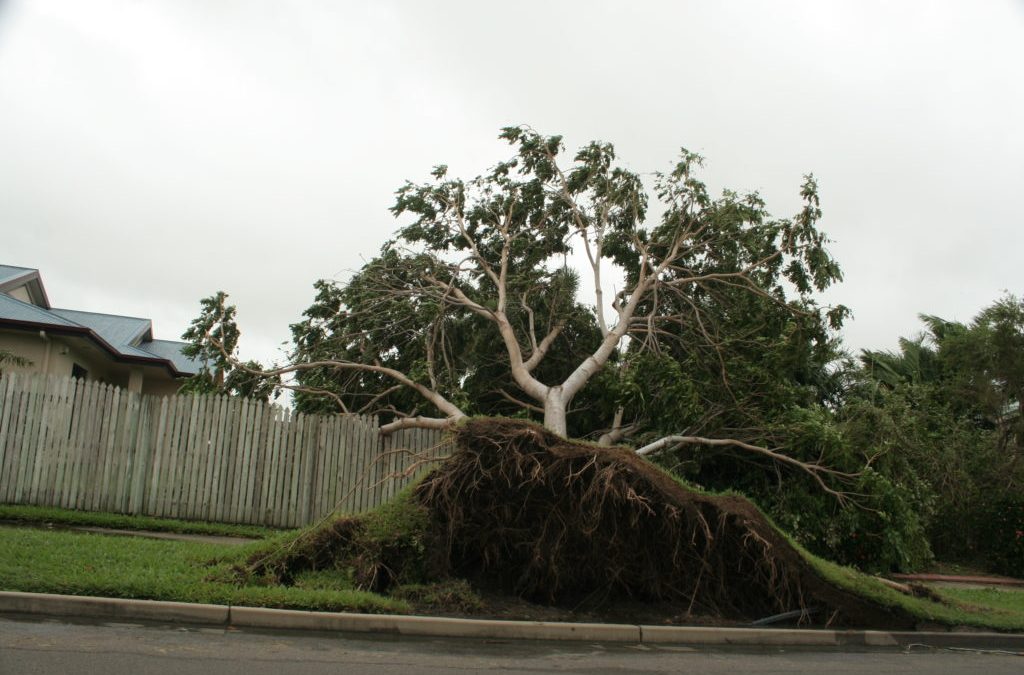Written by Adrianne Gregory and published on https://patch.com/
Ever noticed how a falling tree always seems to come as a surprise to most homeowners, and people in general? Most of us seem to think that trees are so huge and sturdy that it would take an F2 tornado or Katrina-level hurricane winds to completely uproot them. It may not look like it, but trees are susceptible to a sundry of external factors that could cause them to get damaged and fall over. Just like any other living organism on this planet, trees are susceptible to disease, decay, and aging. They grow old and become weak over time. Granted that some trees have double, or even triple, the lifespan of an average human, the fact is they do go through the same aging process as any living thing.
Why Trees Fall Down

Glen Ellyn has seen too many harsh storms this summer. This photo, showing one result of the damage, is especially sad for me to look at.
It is the house I lived in about six years ago, in fact, the house that I remodeled from a one- to a two-story house. My family did a lot of growing up there, and that crunched southwest corner was my daughter’s room.
I asked myself a question that some of you might also have: Why do trees fall down? The answer is partly the tree’s fault, partly suburbia’s fault, and partly human fault. Let me explain.
Many “urban” trees do not have perfect form, which can be caused by above- or below-ground imbalance. Allison Phelps, Public Relations Coordinator for the Morton Arboretum, defines “urban trees” as being planted, rather than just growing naturally like the trees planted along our parkway, which are spaced out rather than growing closely in a more dense forest environment, which helps to shield trees from severe winds. As a result, the Morton Arboretum lost very few trees in recent storms, compared to the streets of Glen Ellyn. Trees planted too close to buildings will also grow crooked, one-sided roots eventually, according to Phelps. Trees that do not receive even or sufficient light will grow in a lopsided way, straining to grab sunlight. This ruins their natural symmetrical shape, making them easier to fall over. Tree trimming by utility companies is another hazard—often hurting the canopy and eventually the upper balance of trees.
Most trees have shallow roots.
Although trees like the ones in our parkway seem indestructible, there is no guarantee that they will not fall down one day. We are more aware of this when it is in our front yard, whereas falling trees are a normal, frequent phenomenon in forests. The International Society of Arborists (ISA), headquartered in Champaign, IL, explains that virtually all trees will have the bulk of their root system (95 percent), located very close to the soil surface. The roots extend far from the trunk and are typically found just 6″ to 12″ below ground. This is where necessary oxygen and most of the soil moisture and nutrients are located.
Very few trees produce actual tap roots (deep anchors) and many outgrow that characteristic as they age. Some trees will develop a deeper than normal root system in response to specific growing conditions (access to underground aquifers in very arid climates) but this is uncommon in a cultivated landscape. In short, the smaller the anchor that a tree (or any plant) has in the ground, the easier it can be disturbed.Subscribe
Roots grab into the soil, which is how it stands up. Very strong winds and especially “micro-bursts” can tip that balance once and for all, causing the tree to finally topple over. Some trees are planted in rocky soil where they just can’t grab. Yet Walnut trees and Oak trees are natives that usually do well here, despite the soil. And they are able to dig deeper roots over many years because they are so slow growing. There is an excellent PDF chart here from the UK Forestry Commission listing the root depth of many common trees in the US. Of course, this means that the soil components also play a role in that anchoring—in addition to the species unique root structure.
Some trees have weak roots. Most Glen Ellyn soil is “heavy clay” or very compacted below the 6-8″ of topsoil. Trees with spongy, soft or brittle roots may not be meant to live in our climate. Non-natives like the Russian Olive might do very well in some soils, but should not be planted based on looks alone. It is especially important to plant trees appropriate for the Midwest—both for our climate and soil type.
Roots of some trees have been damaged. This primarily occurs where the tree roots have been cut or crushed by construction, especially from sidewalk, street, driveway, or home construction projects. David Hubbard at the Alabama Cooperative Extension System explains that trees in the urban environment are constantly recovering from damage caused by lawn mowers, weed whips, construction damage, grade changes, de-icing salts and animal damage (rabbits, squirrels and deer). This is the reason that a Village of Glen Ellyn ordinance requires fencing around trees prior to construction projects. Sometimes even that is not enough. When a major, shallow root is damaged or severed, the whole tree becomes non-symmetrical and prone to toppling.
These factors may not make you feel better if your yard’s shade level has just changed dramatically due to a fallen tree. Yet it is important to understand the relationship between our trees, our cultivated urban/suburban property, and even our lifestyles. It might be time to hug your trees while they are still here.
Original post here https://patch.com/illinois/glenellyn/why-trees-fall-down/.

